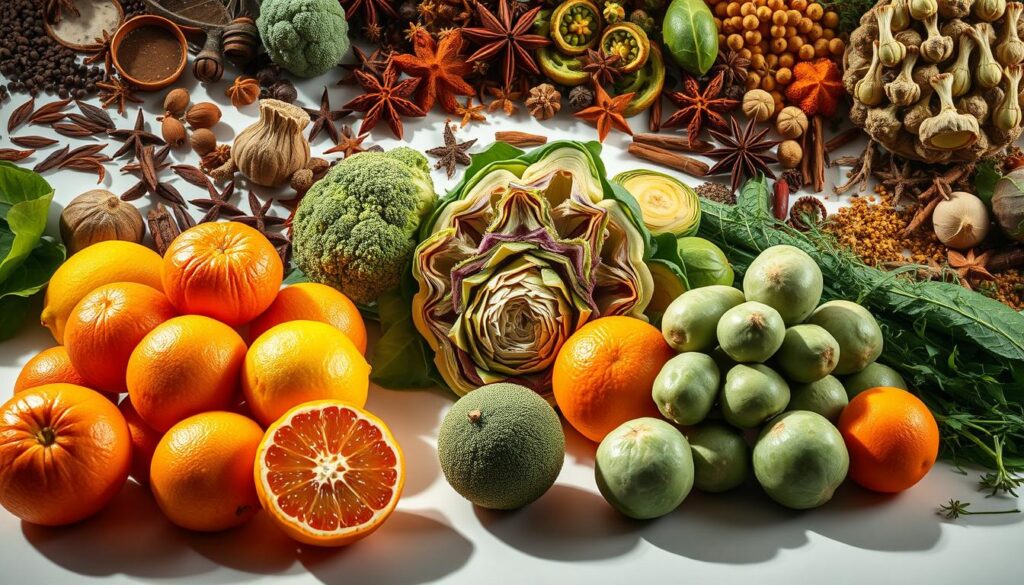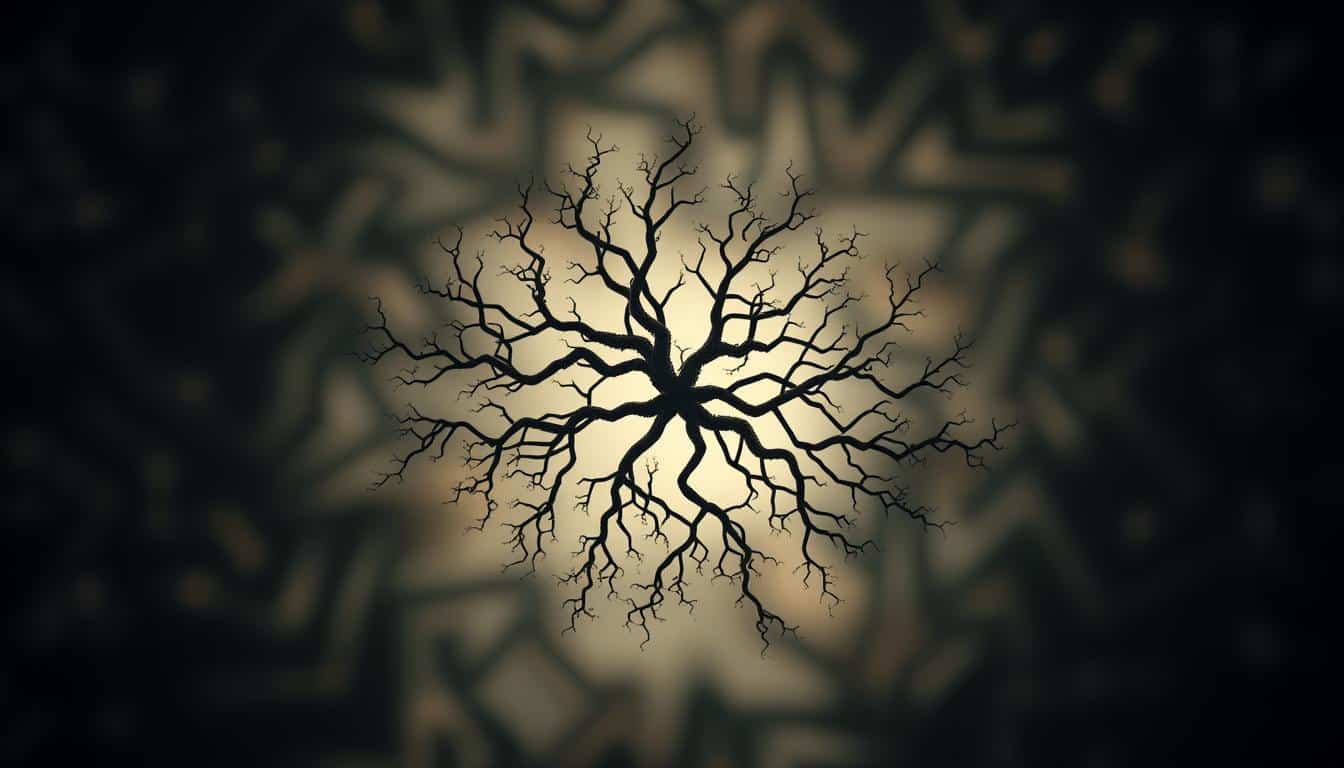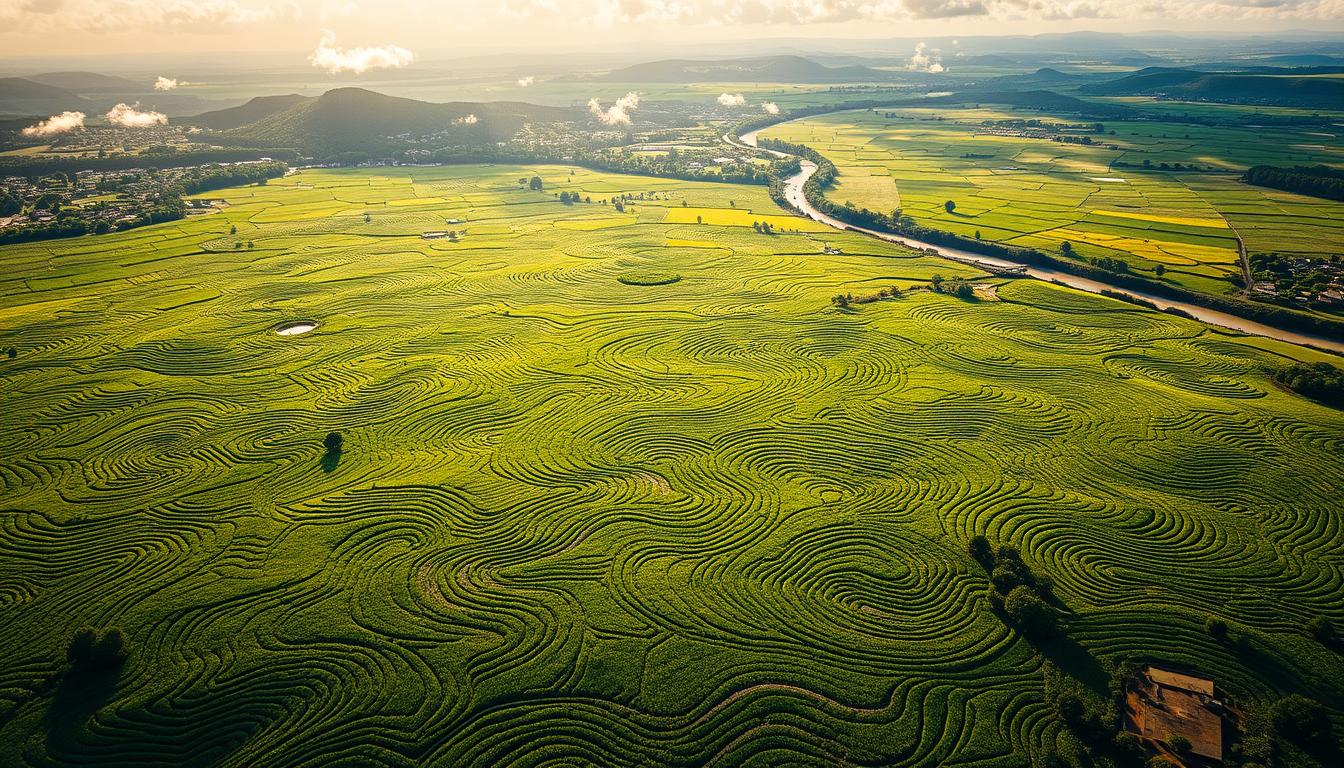The world of gastronomy is vibrant, full of intricate designs from nature. We delve into how fractal patterns influence food design and presentation. Through the beauty of fractals in nature, we see the link to culinary arts. Let’s explore how these fascinating patterns make our food and its presentation richer.
The Fascinating Geometry of Food
The intersection of food and geometry shows how nature affects what we eat. The way food looks has intricate patterns and shapes seen in fruits and vegetables. These designs often mirror nature’s principles, leading to meals that are a treat for both the eyes and taste.
Plants have self-similar structures. These appear as patterns that inspire chefs. They lead to artistic food presentations and a greater appreciation for the beauty of our food.
The Connection Between Nature and Culinary Design
The design found in nature is key to our views on food and art. Food geometry displays various shapes that turn into beautiful, complex meals. For instance, the repeating designs in leaves and fruits bring out an aesthetic. This encourages chefs to use these shapes in their dishes.
This bond shows how nature and design push culinary creativity forward.
Examples of Fractal Patterns in Fruits and Vegetables
Fractals in fruits and vegetables add amazing visuals and textures to food. Notable examples include:
- Sliced persimmons, which reveal beautiful, layered geometries that catch the eye.
- Walnuts, displaying their intricate internal structures that reflect natural fractal beauty.
- Broccoli, showcasing its self-similar patterns that resemble mini trees or forests.
These elements of geometric food art boost dishes’ looks. They also show the deep link between nature and cooking.

Fractal Patterns in Gastronomy and Culinary Arts
Fractal patterns have changed how we see culinary arts. Chefs add these complex designs to their dishes, making food look amazing. This not only catches your eye but also makes the meal unforgettable.
Understanding the Aesthetics of Fractals in Dishes
Fractals make dish presentations complex and engaging. These natural patterns grab diners’ attention and delight all senses. By using fractals, chefs boost their food styling, making each plate a visual adventure.
How Fractal Patterns Influence Culinary Presentation
Fractal patterns change how we enjoy dishes. They highlight a dish’s texture, color, and shape. This storytelling in food deepens our meal appreciation.
Chefs get inspired to try new things, moving past old ways. This makes our dining experiences unique and extraordinary.
The Romanesco Cauliflower: A Culinary Star
Romanesco cauliflower is not just any veggie. It stands out with its fractal patterns and vivid green shade. These features make it more than an ordinary vegetable; it’s a standout in the kitchen. Not only is it a feast for the eyes, but it also adds a unique taste and texture to dishes.
Characteristics of Romanesco and Its Unique Appearance
The spiral florets of Romanesco cauliflower make it easy to spot. Its design is so precise; it looks like nature’s artwork. You’ll find it in shades of green, tasting somewhat like broccoli and cauliflower mixed together. People love its crunchiness, especially when cooked, making it versatile for various recipes.
Recipes That Highlight Romanesco’s Fractal Beauty
Want to make Romanesco the star of your meal? Try these recipe ideas:
- Roasted Romanesco with garlic and olive oil: Enhance its natural flavor by roasting it to a golden brown.
- Romanesco stir-fry: Quickly sauté with other colorful vegetables to maintain its bright appearance.
- Romanesco soup: Blend it into a creamy soup that showcases its unique beauty and flavor.
- Raw Romanesco salad: Toss it in a fresh salad to highlight its crunchy texture and eye-catching shape.
Spirals and Self-Similarity in Food Design
Spirals in nature are a huge inspiration for creating food designs. They are found in shells, plants, and other parts of nature. They create a beautiful view that both chefs and eaters love. These natural shapes have a math concept called self-similarity. This can be used in cooking to make the eating experience more enjoyable for all senses.
Common Spirals Found in Nature
Nature’s spirals are very beautiful and exact, which fascinates people. Some well-known examples are:
- Nautilus shells: These shells show a logarithmic spiral, indicating growth patterns that adhere to certain math rules.
- Fern leaves: With a fractal nature, how their leaves are arranged shows both beauty and purpose.
- Sunflowers: The way their seeds are arranged in spirals is perfect for using space well and showing how nature is efficient.
The Role of Spirals in Culinary Preparations
Chefs use the idea of self-similarity to get creative with how they present food. Using spirals can make dishes look more appealing. They add a special touch to meals. Here are some ways they are used:
- Pasta: Shapes like fusilli make salads and main dishes more interesting and fun.
- Chocolate curls: This technique creates beautiful spirals for topping desserts. It also adds a nice texture difference.
- Vegetable spirals: Spiralizing veggies like zucchini or carrots makes dishes more visually appealing and adds a new texture.
The Impact of Terroir on Flavor Profiles
Terroir is key in shaping the unique flavors of vegetables. It shows how soil quality, climate, and other factors affect taste. This enhances our love for the variety of produce. We will look into how terroir and the traits of different vegetables are linked.
How Soil and Environment Affect Taste
The link between soil and taste is strong. Minerals, pH levels, and moisture change the way plants get nutrients. This changes their taste. For example, tomatoes from rich, volcanic soil are sweeter and more acidic. This shows how important terroir is in making each vegetable taste unique.
Examples of Vegetables with Distinctive Terroir
- Asparagus: Grown in sandy soils, asparagus from the Pacific Northwest is sweet and tender. This is because of the ground’s specific minerals.
- Carrots: The various tastes of carrots come from different soils. Heritage varieties offer a range of flavors from earthy to sweet.
- Radishes: The flavor of radishes is hugely influenced by terroir. Those from clay-rich soils have a spicy taste, unlike those from loamy soils.
The Art of Vegetable Carving
Vegetable carving is where cooking meets art, originally from Japan. It turns simple veggies into beautiful fractal patterns that catch everyone’s eye. The beauty comes from careful cutting and a deep respect for nature.
Japanese Techniques in Creating Fractal Designs
In Japan, carving vegetables is more than just cutting food; it’s a part of their culture. Artists make stunning sculptures of flowers, leaves, and animals. They follow a detailed philosophy, making each piece special.
Using fresh veggies like radishes and cucumbers, every artwork is one-of-a-kind. This shows not only creativity but also a respect for freshness.
The Time-sensitive Nature of Food Art
This art form is all about timing because carved veggies don’t stay fresh for long. They lose their color and shape quickly. Chefs and artists have to be quick to keep their work looking good.
This challenge makes vegetable carving even more exciting. It’s all about making something beautiful in a short time.
Fractal Geometry in Culinary Techniques
Modern chefs are mixing fractal geometry with their cooking styles. This mix makes food look amazing and offers an intriguing dining adventure. They use fractal principles to make their dishes look more appealing. This raises the level of how food looks on your plate.
Innovations in Food Presentation and Design
Chefs get creative ideas from fractal geometry’s complex patterns. They play with different shapes and textures to make their food stand out. By stacking ingredients in fractal shapes or using special plating tricks, they show off the beauty of symmetry and complexity.
How Chefs Use Geometry in Cooking
Chefs are getting into fractal geometry to spice up their cooking. They cut ingredients to show off symmetrical patterns or arrange food in fractal-like designs. This blend of geometry and cooking lets chefs present meals that taste great and look visually pleasing. It encourages guests to enjoy both the flavor and the artistic presentation.
The Link Between Food and Politics
The link between what we eat and politics is gaining attention. The Slow Food Movement leads the fight for better food politics. It calls for *sustainable culinary practices* and asks us to think about the impact of our food choices. This movement shines a light on how our food choices affect communities and nature.
The Slow Food Movement and Its Philosophy
The Slow Food Movement started as a pushback against fast food. It aims to bring people closer to where their food comes from. The movement values age-old food traditions and supports local businesses.
Those involved take part in farmer’s markets, support local agriculture, and enjoy food festivals. These activities show respect for local food and the people who make it.
Advocating for Sustainable Practices Through Culinary Choices
Choosing what we eat can help promote sustainability. The Slow Food Movement wants us to eat organic and local foods. This supports ethical farming and cuts down on transportation emissions.
By picking *sustainable culinary practices*, we help protect biodiversity and the environment. We also back farmers who care about nature. With every purchase, we influence food companies and shape food politics.
Embracing Complexity: Chaos Theory in Culinary Arts
Chaos theory and culinary arts together show us the vibrant, changing nature of food making. By accepting this complexity, chefs gain a deeper insight into cooking. They move beyond simple recipes to adapt and thrive amidst the unforeseen in cooking.
The Benefits of Viewpoint Nuance in Cooking
Using chaos theory in cooking boosts creativity and new ideas. Chefs can mix up flavors, textures, and visual styles freely. This approach leads to surprising, enjoyable dishes, making meals more memorable.
Connecting Culinary Practices to Complexity Theory
Chefs get how everything in cooking connects by studying chaos theory. Things like timing, heat, and how ingredients mix matter a lot. Knowing this complexity makes meals better. It also encourages respect for the environment and food sources.
Conclusion
In our exploration of fractal patterns in cooking, we found a deep link between nature and what we eat. From the cool spiral of a nautilus shell to the detailed shape of Romanesco cauliflower, the summary of fractal patterns shows how these designs make our food look and taste better. They turn a simple meal into something amazing.
By understanding fractal geometry, we start to see food in new ways. We notice the art in how it’s prepared. As chefs use these gastronomy insights, they mix nature’s patterns into their dishes. This blend of math and cooking shows how important beauty is when we eat. It makes our meal experience better.
This trip into the mix of fractals and food tells us to try new things in our cooking. It’s a call to use these awesome patterns ourselves. By doing so, we mix nature and art in our kitchens. We remember that cooking is more than just making food. It’s about creating something beautiful and feeling a deeper connection to the world.



